Maltese Tradition of Crib Making
If you’ve lived in Malta for a while (like me!), you’ve realised that Christmas cribs form a great part of the country’s tradition. Maltese Christmas would not be the same without the traditional presepju (crib) and pasturi (nativity figures). Cribs are positively everywhere, from private houses, garages, small chapels to large churches. Visiting cribs is actually a popular activity at Christmas time.
Many locals and tourists alike spend time going round touring the various ‘presepju’ displays. Some of those are very artistic and elaborate, with mechanically moving figures, running water and so much more! The degree of detail that comes from hours of meticulous work by dedicated craftsmen is mind blowing!

This festive season I had a great pleasure to meet with Anthony Camilleri from Birzebbuga to admire his stunning crib, but also to understand a bit more what it involves and what’s going on behind the scenes.
Before I start to share with you what I’ve learnt from Anthony I would like to begin with a brief introduction of crib making / building tradition on the Maltese Islands.
Crib Making History in Malta
The idea of crib building originated in Italy in 1223. From here it spread all over Europe and eventually the world. Each country adapted their own trades, traditions and style of costumes. Crib building in Malta is believed to start in the first half of the seventeenth century. The earliest Maltese crib known was built at the Dominican Friars Church in Rabat Malta in 1617.
The art of crib building in Malta was mainly influenced by the Neapolitan & Sicilian style. The Neapolitan style was quite popular in Europe until the end of the last century. The Sicilian style of crib, was introduced in Malta by a Franciscan friar from Sicily, Benedetto Papale, who is known to have lived in Malta for some time during the second half of the nineteenth century.
In the middle of the 20th century, and particularly after the end of World War II, new customs and traditions were brought to Malta from abroad. Local traditions and folklore were unfortunately pushed aside. The crib building tradition in Malta was kept alive by a few enthusiasts who continued building cribs and showcasing them to the public. It’s thanks to these persons that the custom of crib building in Malta did not vanish altogether and that we can witness it until this very day!

In 1986, a group of Crib enthusiasts got together and even formed the ‘Association of the Friends of the Crib‘. The scope of the group was specific: to keep the crib tradition in Malta alive. Until today they organise crib-making workshops.
Christmas Cribs Types and Sizes
In Malta two types of cribs were made – in the shape of a grotto and the traditional large crib. The popular family crib (‘presepju tal- familja’) is made with simple materials such as, thin wood base, chicken wire to hold the structure and covered with ‘paper mache’, made with flour glue.
The sizes of Christmas Cribs vary from ‘shoe box’ size all the way to life-sized nativity scenes that can span a whole village square. The second one has become a popular attraction, and more villages are hosting their own Presepju Haj (Live Nativity Scene). Eleven years ago the village of Ghajnsielem in Gozo started their own tradition. In 2008 number of abandoned fields were converted into a Nativity village.

This initiative was so successful that it has been repeated annually ever since! The main attractions include the carpenter and blacksmith’s dwellings, the bakery, a local crafts area promoting traditional skills and folklore, a tavern and of course the highlight of this journey is the Grotto where a poor unknown couple is tending their newly-born Baby Jesus with a donkey and a cow close by. If you’ve never been, you can read all about it here.
Hand-made Crib by Anthony Camilleri
Anthony Camilleri is 51 year old father of two young ladies from Birzebugga. Without any prior crib making experience, he built by himself this amazing Christmas crib. The one and only he ever did.
The creation of this Neapolitan style crib took over 3 years. This type of crib is also called ‘borgo’, which basically means houses on top of each other, windows facing other houses, narrow passages… Everyone in the ‘village’ knows everyone and what are their neighbours up to.
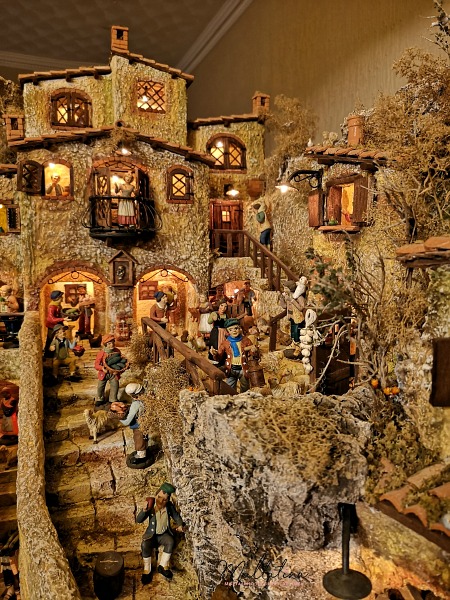
Anthony creates the entire structure of the crib, all the houses, doors, windows, pathways, etc. Everything is as realistic as possible and fully functioning. The doors and windows open and close, the lights go on and off, the water in the fountains is real and flowing.
Although Anthony buys all the figures he adjusts them to his needs. For example once he bought 3 men carrying a bag of flour. He kept one and removed the bags from the other two, which he placed next to the bakery. The empty handed figures got baskets of fruit and grapes instead and play another role in the crib.

All the shepherds are made in Naples and there are about 130 of them. And another 30 new figures are still waiting in the box to be placed. As it was already said, the crib can take various forms and structures and the same can be said for the variety, type, size and style of figurines that populate the cribs.
The figurines that are used need to match the size of the structures and that is actually one of the first considerations when planning out a crib. The size of Anthony’s shepherds is 10cm. The sizes vary from as small as 4cm to 30cm and probably even more! So whatever size you decide on, the crib has to be built in the correct ratio. Just like us and our houses.

The super realistic looking fruit is made out of polymer clay. Which are also bought, but placed carefully and thoughtfully to create authentic fruit market.
This fully functioning fountain that you can see in the picture above was made by Anthony and took four days to produce.

Look at this great detail of this stall! The cookware was bought, but Anthony created the stall, with all the hooks, shelves and small roof covered with terracotta. And this is just one of many stalls spread around the square.
Crib Making Step By Step
It’s gorgeous, isn’t it, but where do you start from? First you design the house, the windows and the doors. The basic structure is made out of polystyrene, wood and tiny bricks.
To cover the bare material you make a mixture of white glue, chalk, some tile glue to make it stronger and you also add some wood flakes. You steer the mixture until it has a creamy consistence and then you apply it with the brush on the basic structure.
Every single layer you need to let try for 3 days and repeat the process until it’s about 3 mm thick. Afterwards you cover it with a layer of English chalk. Then you paint it.

As Anthony says, before you design and make anything, you have to really think about it. How is it going to fit in, how is it going to work, how am I going to repair it?

This is what you see when you remove the protective wooden cover from the back. You can access the back rooms from here, all the wiring is here as well. There are more than hundred different lights in the entire crib. Therefore there was a need for a clever and colour coded wiring system so if one light is faulty you can easily find out which wire it could possibly be.
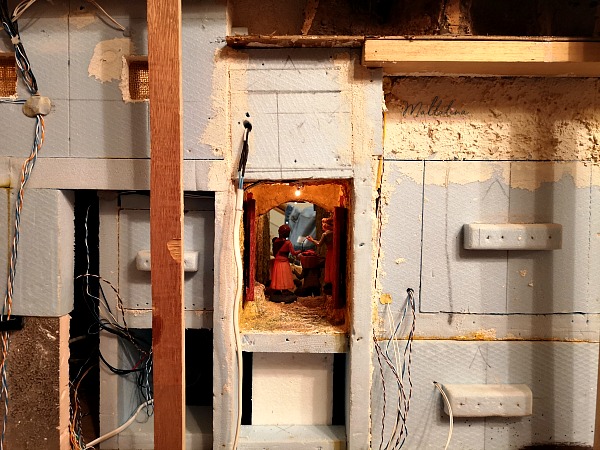
This is a very rare sight of what Christmas crib looks like from behind. You can usually see the glorious front part, but this is not any less interesting for me.
The rooftops are made out of real terracotta, which is very hard clay-based ceramic and you need proper tools to cut it. They are all removable giving the access to decorate or repair each room.

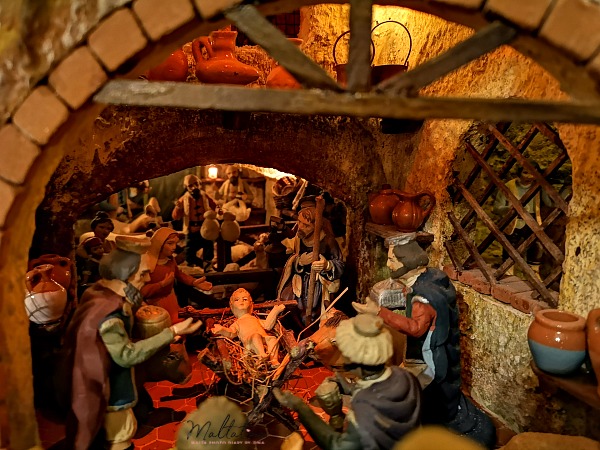
The ‘Nativity scene’ is the main part of each crib. Look properly and notice how deep the ‘room’ is! Behind the baby Jesus you can see the milkman!
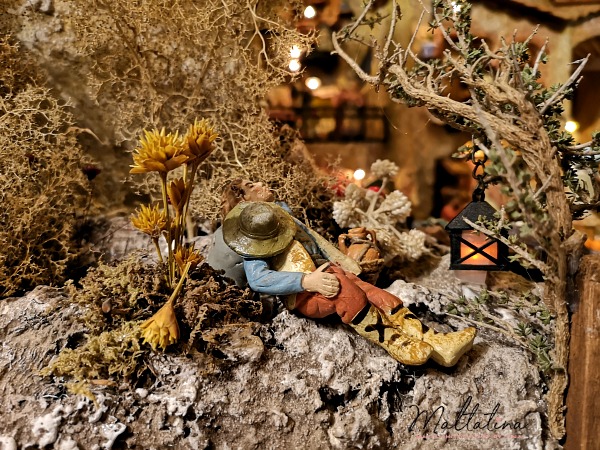
The plants used to decorate the crib are real dried plans that need to be changed every now and then. The napping shepherd is resting on a piece of natural cork. There is about 35kg of it! It takes 3 people to carry the crib and it’s still very heavy. So guessing it weighs at least 60kg!
How to store & protect a crib?
Throughout the year the crib is stored in Anthony’s garage covered in plastic. The shepherds and all other items on display are stored separately.
Did you know that there are about 50 different insects that could eat the polystyrene and other parts of the crib?! Therefore Anthony has to buy a canister containing a special liquid that after it’s lit up it makes smoke that kills all the unwanted bugs! This is an annual procedure to avoid unwanted surprises of the crib being eaten from inside!

Is This Crib For Sale?
You maybe wondering how much is this crib worth or if it is for sale. Anthony told me that just last week he was offered 5,000eur but he wouldn’t sell it not even for 10,000eur. Why? Because for him it’s priceless. It’s something he wished he could have since he was 6 years old, but couldn’t afford. It has very high sentimental value and he wishes it will be passed on to the next generations.

Is The Crib Completed?
Do you think that the crib is perfect as it is? Wrong! 🙂 Anthony is a perfectionist, as you can see from this state-of-the-art crib, and every time he looks at it, he is not completely satisfied and adds something to it. The size of this crib is about 180cm x 120 x 90. Pretty big right? Not big enough! Anthony is already planning to expand the crib in 2020!
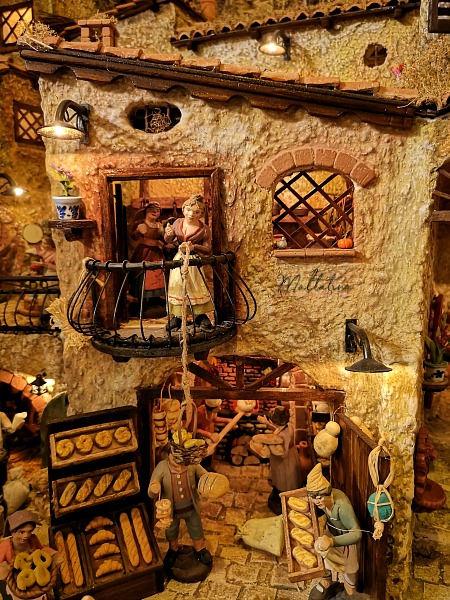
Can I See it to Believe it?
Does it look just too perfect to be real? Would you love to see this outstanding crib? Usually Anthony is more than happy to welcome you to his private house in Birzebugga and show off his creation. Unfortunately this year due to the current situation, private viewings are not possible.

Maltatina’s Memory Game
Do you like my photo blogs? Yes! Did you know that I’ve launched Maltatina Memory Game Vol. 2 featuring even more of the most beautiful places in Malta? You can buy it here. By purchasing my products you’re helping me to keep the blogs coming. Thank you. 🙂



